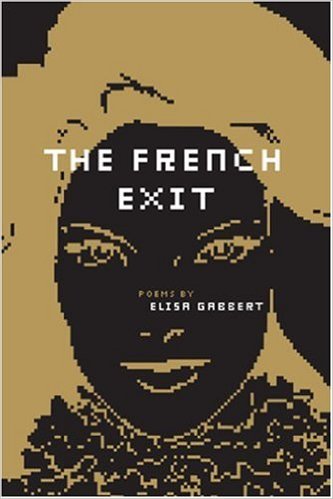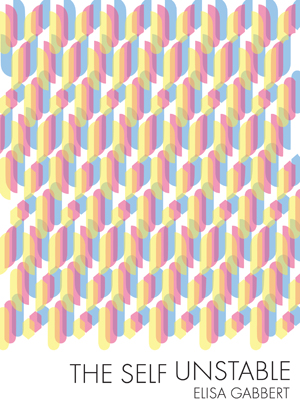The French Exit and The Self Unstable by Elisa Gabbert
Review by Sarah Katz
Elisa Gabbert mocks coherence in her books, The French Exit (Birds LLC, 2009) and The Self Unstable (Black Ocean, 2013). She pokes holes into the all-too-certain language of “identity,” the profundity of the aphorism, and the divisions between poetry and essay. Ultimately Gabbert seeks to expose the porousness between all things and genres, fashioning slippages that tease the reader into questioning his or her own comprehension of reality.
The books differ, of course. The French Exit, a three-sectioned collection of mainly couplet poems, reckons with a speaker’s anxiety about time, while The Self Unstable, a book of five sections labeled “Essays/Literature” (which could easily be called prose poems) attempts to explore identity construction through a second person narrator.
First, The French Exit: the book offers poems that reveal Gabbert’s powers of combining essay and poetry. “X,” for example, challenges mind-body dualism in a manner that suggests the possibilities of hybridity:
Mindless, the body is perfect,
an outline—form without
content, absent of tone, lying
in the street. Faint halo of white
where it touches the concrete.
[...]
I want to lie on the top level
of an empty garage, to be close
to the sky as I lose my mind—
I’m afraid. I’m afraid
I’ll feel pretty
transcendent.
The immediate strangeness of this poem derives from its unusual, generalizing claim fashioned out of mind-body dualism discourse: that the body is “perfect” when unpolluted by the mind. Yet, at the same time, Gabbert employs the image of her own “transcendent” suicide—“Faint halo of white / where it touches the concrete”—thereby blurring the lines between cultural commentary and intimate aside. With so many caesuras evoked by rhymes (“...lying / in the street. Faint halo of white / where it touches the concrete.”), one moves at the speaker’s confession haltingly until the piece reaches its peak of meaning. The result is a poem-cum-essay that feels confessional and yet essayistic at the same time.
Indeed, “X” somewhat exemplifies the governing title of the “French exit,” which, as a Slate article explains, is a phrase for “ghosting,” or leaving a party without saying goodbye. As a collection about death, French Exit asks for clarity about what it is to live: If one can find beauty in suicide, then does that make a person more capable of suicide? Does one “leave” existence on one’s own accord, or are there elements that prescribe leaving? How much of experience is hierarchical?
Ultimately, The French Exit seeks to use form to draw out complications between not just free will and consciousness but also the dynamics of representation. “Ornithological Blogpoem,” for example, a prose poem in section two (in which all the poems are “blog poems”), personifies birds who seem both threatening and nonthreatening: “Do not be afraid of angering the birds. What angers the birds is fear.” Using understated syntactical acrobatics here—“do not be afraid of” and “What angers the birds is fear”—Gabbert complicates the idea of a “certain” or “static” representation; at the same time, the poem as a “blog poem” also suggests its own instability.
In The Self Unstable, Gabbert more fully realizes the essayistic tendencies and thematic concepts of The French Exit; she moves away from the spelled out cynicism and fear in the first book and toward a kind of tonal objectivity. More specifically, Gabbert reemploys the aphorism as an approach of universal uncertainty rather than certainty: her work sings at the intersection of aphorism and aporia. As a result, The Self Unstable feels like both an intimate conversation with the reader about her childhood and love life, and yet also the suggestion that the speaker is “unstable” or constructed.
The proem defines the terms of the book:
What was the self?
You wanted a life of causes, but it was all effects: you could never get before.
Finding meaning in the meaningless was no kind of meaning, but you were satisfied with meaningness.
[...]
The only way past is through.
Here, Gabbert establishes the theme of the self as “unstable”: the “present” and “future” are only decipherable by going “through,” (which is what the book attempts to do). Still, it’s unclear whether the goal is to surpass the self, or to enter the past through the present: an instability of meaning that Gabbert creates, once again, to mock coherence.
In the first section that follows, “The Self is Unstable: Humans & Other Animals,” the mood of instability creates a distance between the speaker’s self at the same time that the pieces wrestle with what the self wants: to be “loved or misunderstood?” The effect is one of a compelling boredom: the speaker establishes that animals and human beings aren’t very interesting; mussels, crows, dolphins, and kittens all lead blasé existences—“All species evolve toward overspecialization. If you find anything other than food or sex interesting, it’s signaling.”
In the following sections, “Transcending the Body: Memories, Dreams, Fears, & Fantasies,” “A Crude Kind of Progress: Art & Aesthetics,” “First-Person Shooter,” and “Enjoyment of Adversity: Love & Sex,” the implicit claim of the first section remains: “thought is flawed.”
One of my favorite pieces in the book in section two illustrates the evasiveness of language for portraying one’s sense of self as affected by dreams:
I was bitten by a feral cat, who left her fang behind in my hand. My dream life has its own past, memories I only access when asleep. When something hurts in a dream, where do you feel the pain? Is there an analog in the real world? And likewise, for the beauty? If we can’t change the past, regret is a waste of time, but not worry or longing. Still, I prefer regret. If time is a vector, we are passengers facing the rear of the train.
Gabbert predicates this piece on the semantics of experience, using aphorism and the image to question the types of pain one might feel. The result is a kind of outburst, and then, with the final image, a move away from the subject.
Gabbert’s books are unlike any that I’ve read, and they diverge from other diarist prose and poetry collections in their focus on form. This is not a writer content with accepting the conventional definitions of the diary, essay, or poem. Gabbert’s commitment to unhinge us readers from the comfort of certainty and push us deep down the rabbit hole is an incredible gift.
______________________________________________________
About the Author:
Elisa Gabbert is the author of the chapbooks Thanks for Sending the Engine from Kitchen Press, and, with Kathleen Rooney, That Tiny Insane Voluptuousness (Otoliths), a collaborative collection. She is the poetry editor of Absent and currently works at a software startup in downtown Boston. She blogs at The French Exit.
About the Reviewer:
Sarah Katz is Publications Assistant at the Association of Writers & Writing Programs. She has an MFA in poetry from American University, where she received the Myra Sklarew Award for her thesis. Her work appears or is forthcoming in MiPoesias, NANO Fiction, RHINO, The Rumpus, and others.


